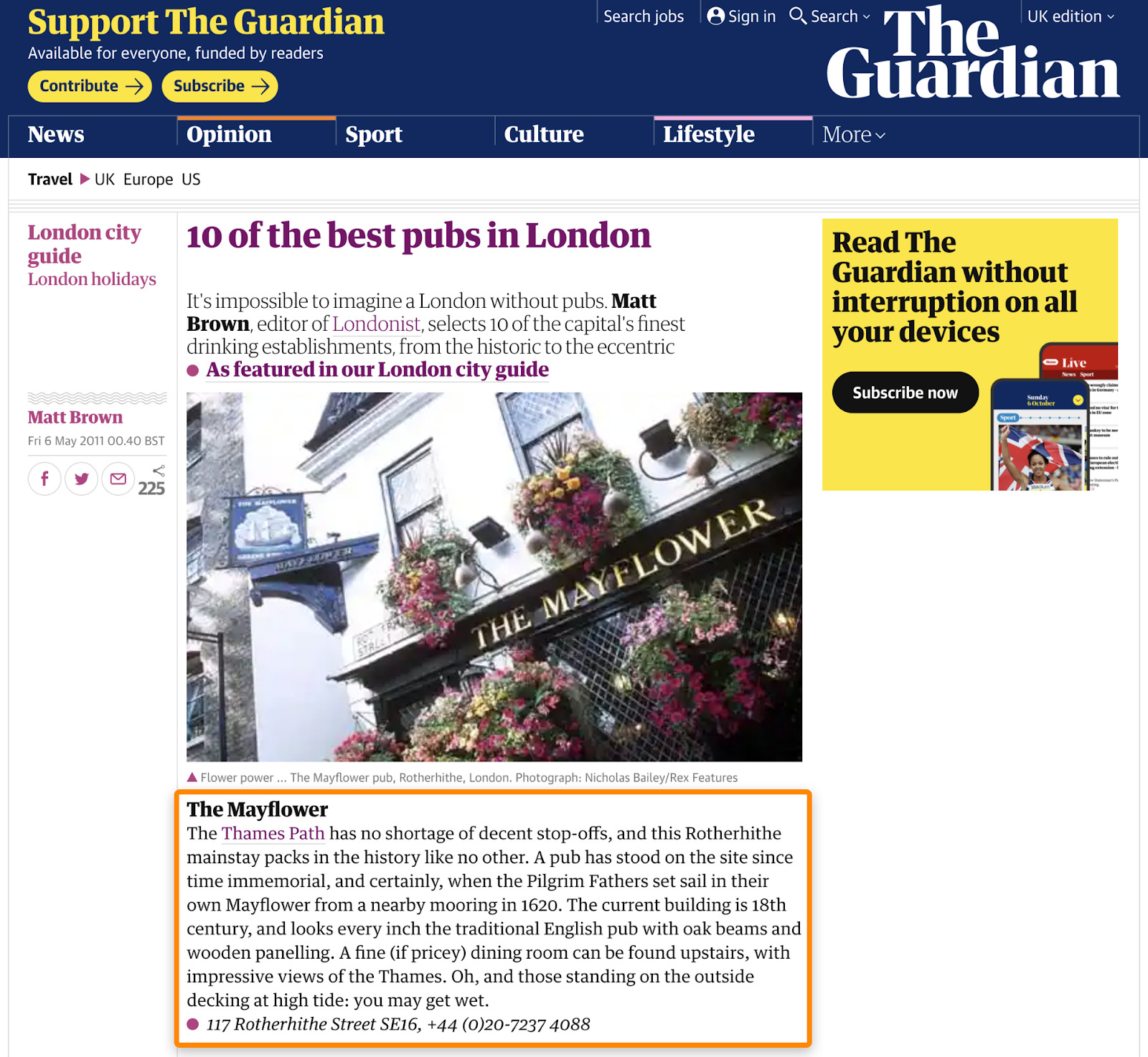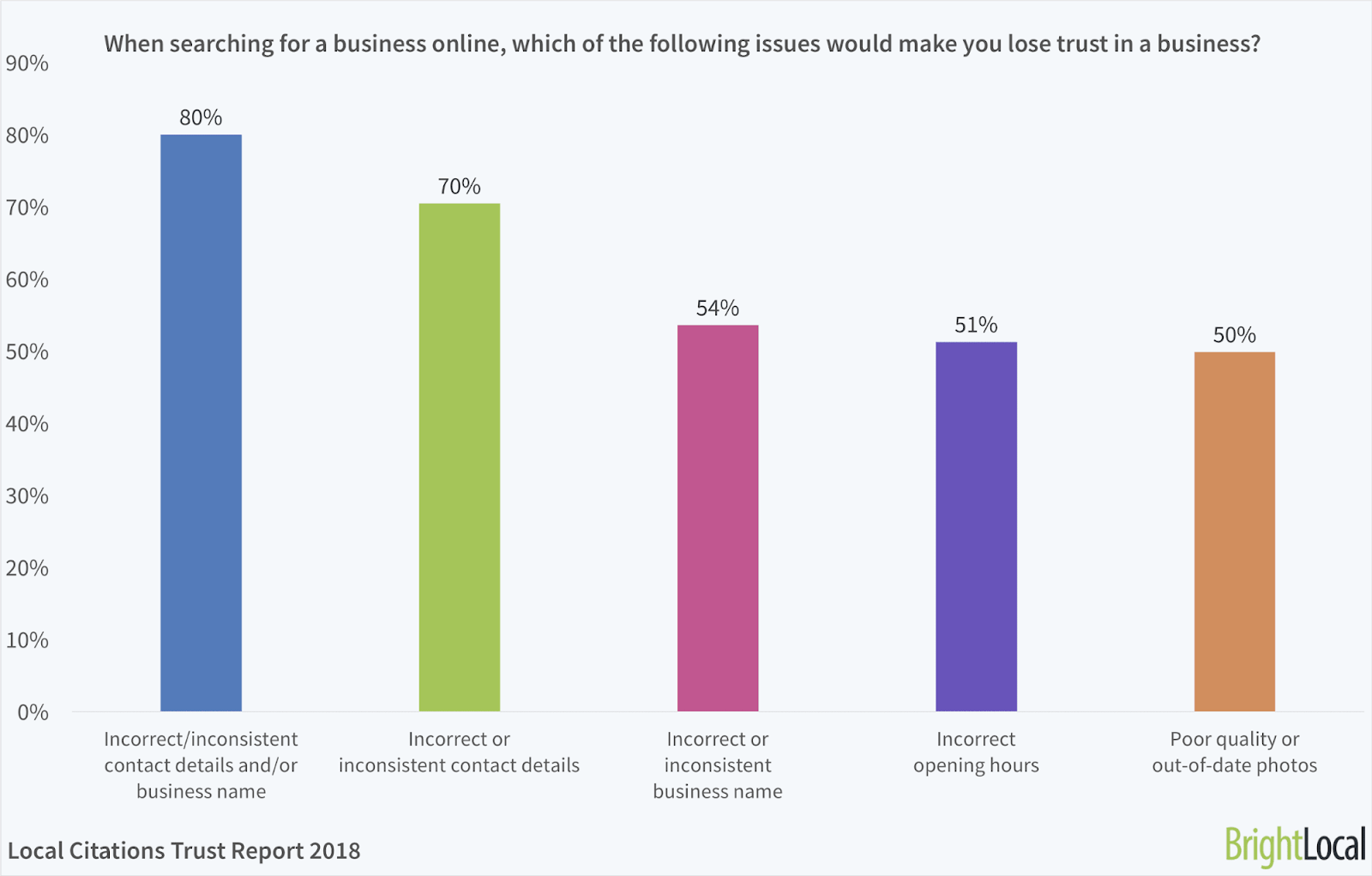Citations appear in lots of different places: business directories, social networks—anywhere someone might be looking for information about local businesses.
Here’s an example of one for a coffee shop in New York:

This is known as a NAP citation because it shows the shop’s name, address, and phone number.
In this guide, you’ll learn:
- Why local citations are important
- What types of citations there are
- How to get citations
- Why consistency and accuracy matter
Citations are useful for two main things:
- Ranking higher for local search queries (maybe)
- Helping people discover your business online
How citations help with local SEO
Citations are believed to help search engines verify the existence, legitimacy, and trustworthiness of your business. If the same details appear across many relevant and trusted websites, then Google likely has increased confidence that your business exists, is operational, and that what you say about it is true.
According to a survey by Moz, citations are the fifth most important ranking signal for local queries.

That said, it’s worth pointing out a couple of things about this survey:
- It’s a few years old. The survey was conducted in 2018. Given that citations have almost certainly been decreasing in importance over time, it’s quite likely that they are less important today.
- Not all SEOs believe that citations are still important. Even in 2018, there were quite a few SEOs who responded to Moz’s survey saying that citations were no longer of huge importance, and didn’t move the needle all that much.
That last point is an important one and one that we generally agree with.
Getting local citations from anywhere and everywhere is unlikely to have a big impact on your local rankings. However, we believe that there’s still some value in getting citations from relevant, trusted sources where people expect your business to be listed.
For the record, here’s what Google’s John Mueller says about citations:
Just because a company name is mentioned somewhere doesn’t necessarily mean it’s good or bad for the company. I’d see those mentions more as advertising — if you think people are going to see it and explicitly search out your business, then that’s great.
How citations help people to discover your business
People don’t always use Google to find local businesses. They often turn to sites like Yelp, Yellow Pages, and specialist directories like lawyers.com. That’s one of the reasons why it’s useful to get listed on these sites.
The other reason is that business directories often dominate search results for local queries.
For example, try searching for “plumber nottingham”:

Very few of the top results are plumber’s websites. They’re mostly business directories that list lots of different plumbers.
Because Google returns these types of results for local searches, you need to be cited there for searchers to find your business.
Before we talk about how to build citations, we need to understand the two types of citations you can get.
Structured citations
A structured citation lists the name, address, and phone number (NAP) of a business. Directory listings and social media profiles are good examples of these. Each company’s information is displayed in the same way, and the page is effectively built around that data.

Unstructured citations
An unstructured citation is a contextual mention of a business. They usually show up in blog posts, forum posts, or as a result of press mentions.

Most businesses will benefit from having some structured and unstructured citations. But there’s no need to get them from every site you come across. It’s very much a case of quality trumps quantity here.
Follow these four steps to build the citations you actually need:
- Get listed with the ‘big three’ data aggregators
- Submit to other core sites
- Submit to popular industry and local sites
- Pursue unstructured citations
Step #1. Get listed with the ‘big three’ data aggregators
There are thousands of business directories on the web. If each of them relied on business owners submitting NAP information directly, they’d probably have a lot of gaps in their data. Most business owners just aren’t going to submit to thousands of websites.
Data aggregators solve this problem. These companies collect information about businesses and distribute it to hundreds of other websites. If these folks have your information, you’ll end up with citations in lots of places.
In the US, there are currently three main data aggregators:
It’s completely free to claim, submit, and manage business listings with InfoGroup (Express Update) and Neustar Localeze. Just search for your business and claim the listing if it’s there. If not, submit a new one.

Just make sure to search for your business thoroughly and claim any listings before submitting a new one. You need to make sure that you claim any duplicates and that the information is correct.
With Factual, you can no longer update or edit listings directly. You have to work with one of their Trusted Data Contributors (TDC), and that usually costs a small fee. My advice is to search their directory for your business and check the information they have. If it’s accurate, no worries. If it’s inaccurate, then you can always work with a TDC like Yext or WhiteSpark to correct it. However, my personal opinion is that it probably isn’t worth it for most businesses, so don’t worry about Factual too much.

Step #2. Submit to other core sites
The ‘big three’ data aggregators distribute NAP information to many well-known sites, but not all of them. That’s why it’s often useful to submit to the core sites in your country directly.
In the US, these are sites like:
- Apple Maps
- Yelp
- Bing Places
- YellowPages
- BBB
- Foursquare
You can find a full list of the most important citation sources in the US here, and for other countries here. Just know that this is only one company’s interpretation of the “most important” citation sources. There are plenty of these lists around, and while there is undoubtedly a lot of overlap, they’re rarely identical.
Personally, I don’t believe it’s worth submitting to all these sites. I’ve never even heard of most of them, and some seemingly get hardly any traffic.

That’s hardly surprising given how this particular site looks. I can’t imagine anyone using this to find a local business (maybe in 1995?)

My advice, then, is to look through this list and submit to the sites that seem worth it.
How do you know which ones they are? If you’ve heard of them, then chances are they’re worth submitting to (assuming it’s free). Otherwise, a good proxy for quality is to Google “[your industry] in [location]” and see if they’re anywhere to be seen in the top 100 search results.
For example, if we search for “plumber in new york,” we see Thumbtack and AngiesList in the results.

In terms of submitting your business to these sites, you have two options.
Submit manually
If you have plenty of spare time and don’t mind mundane tasks, you can submit to these sites one by one. Just search for your business on each seemingly worthwhile site. If it’s already there, make sure the information is accurate. If it isn’t accurate, look for an option to claim the listing (most sites have this) and correct the errors. If it isn’t there, add it.

You might also want to claim the listing so you can add more information about your business. For example, Yelp lets you add photos and tons of other details after you claim the listing.
Given that this process is pretty tedious and time-consuming, one tool that can help is Yext’s Business Scan. It effectively automates the process of checking whether you have existing listings on the “most important” sites. All you have to do is enter your business information, and you’ll see a report like this:

If there are any “missing” or inaccurate listings, just head to the site, search for your business, and add or correct it.
Use a submission and management service
Submitting the same business information to multiple sites by hand is nobody’s idea of fun. That’s why a few companies have built solutions to make this process easier. Yext is perhaps the most well-known of these companies. They integrate with hundreds of well-known sites directly, meaning you can submit and manage your citations from one place.
You’ll even find that some sites only allow submissions through Yext.

That said, Yext isn’t the only company to offer submission and management services. Companies like BrightLocal and Whitespark offer them too.
In terms of whether these submission services are worth it, it’s hard to say. Every SEO will have a different opinion on that. Personally, given that these services are far from cheap, I would say that your money is probably better spent elsewhere. I would just manually add listings to the handful of sites that matter most and call it a day.
Step #3. Submit to popular industry and local sites
Now that you’ve taken care of the “baseline” citations, the next step is to hunt down popular industry-and-geo-specific citation opportunities.
For example, if you run a hotel, you’ll want to make sure you’re listed on TripAdvisor. If you’re an attorney, then you’ll want to make sure you’re on findlaw.com. If you’re a realtor, then you should be on realtor.com. You get the picture. These are industry-specific citation opportunities.
The physical location of your business will give way to more citation opportunities. For instance, you’ll probably want to get listed with the local Chamber of Commerce and other local business associations.
There are a few ways to find these opportunities.
a) Use Google
Head to Google and search for simple things like:
[location] chamber of commerce
[location] business directory
[industry] business directory
[industry] business listings

There’s no need to submit to every site you come across. Use your best judgment to identify the sites that are worth it.
b) Use an industry citations list
There are quite a few of these online, although this one from BrightLocal is one of the best. It lists popular citation opportunities for over 40 business categories.
c) Use Ahrefs’ Link Intersect tool
Most citations feature the business’s name, address, phone number, and website URL. This is known as a NAPW citation (the “W” stands for “website”).
Although these backlinks are usually nofollowed, you can use their existence to discover citation opportunities. Just search Google for competing businesses, then paste three or more of their homepage URLs into Ahrefs’ Link Intersect tool. In the bottom field, add your homepage URL and set all the modes to “URL.”

Hit “Show link opportunities,” and you’ll see websites that link to one or more of the homepages you entered, but not yours.

However, it’s quite hard to tell why these links exist from the list alone. So you’ll want to hit the caret to get more context about each link.

The one above looks like a directory listing. We can confirm that by visiting the referring page.

Remember that these are all sites that you don’t have a link from. That means you probably aren’t already listed there.
Hit the caret on any site on the list to see its SEO metrics, including estimated organic traffic. This can help you tell how popular the site is, and whether getting listed is a priority.

Step #4. Pursue unstructured citations
If you’ve gotten to this stage, then you’ve likely already trumped most of your competitors when it comes to structured citations. What we haven’t really talked about yet are unstructured citations.
Unstructured citations are a different beast altogether. They tend to come from press mentions, reviews, and blog posts about your business. That means they’re harder to get than structured citations. Someone actually has to care enough about your business to write about it.
For example, Milk Beach, a London coffee shop, gets cited in this article from GQ about the best coffee shops in London:

You’ll notice that there’s also a backlink to the coffee shop’s website, and it’s a ‘followed’ link too. That’s common with unstructured citations, and it’s partly why they’re so powerful for SEO.
Let’s look at a few ways to find unstructured citation opportunities.
Use Google
One low-hanging source of unstructured citations is supplier pages. Lots of businesses have these. They list and link out to the companies they supply, or that supply them.
Here’s an example of one:

You can find these quite easily in Google. Just make a list of your suppliers, find their websites, then search for something like:
site:yoursupplier.com intitle:“stockists”
site:yoursupplier.com intitle:“suppliers”
site:yoursupplier.com intitle:“clients”
You can also just look through their sites. It’s not usually that difficult to find these pages if they have them.
Use HARO
HARO (Help A Reporter Out) connects journalists with sources for upcoming stories. It’s free to use, and works like this:
- You sign up.
- You get daily email alerts with questions from journalists.
- You answer a question or give a quote.
- You usually get cited if they use it in their upcoming article.
It takes a bit of time and effort, but it’s a great way to get high-quality citations and links.
Use Ahrefs’ Site Explorer
Since most unstructured citations include a link to the company’s website, you can find citation opportunities by checking your competitors’ backlinks.
Let’s say you run a coffee shop in London. Just enter a competing business’s domain into Ahrefs’ Site Explorer, set it to URL mode, head to the Backlinks report, then filter for “Dofollow” links.

From here, it’s a case of looking for trends that might translate to opportunities. For instance, if we eyeball the report for Milk Beach, there are a lot of links and citations from lists of the best brunches in London.

Is that useful information? It depends. If your coffee shop doesn’t serve brunch, probably not. But if it does, and if your customers regularly rave about it, it might be worth getting in contact with some of these bloggers and journalists.
For example, the lady behind this blog cites her five favorite brunch locations in this article:

If she hasn’t mentioned our coffee shop, it’s either because she’s never been there, or because she didn’t like it. So it might be worth sending her a friendly email, and perhaps even inviting her down for a bite to eat. If she takes us up on our offer, she might add the shop to her post or even write a standalone review.
Here’s another citation that stood out in the Backlinks report:

This one comes from a gluten-free food blogger. Now, it probably wouldn’t make sense to reach out to her as she no longer lives in the UK. But assuming we have some tasty options for celiacs, we could look for other gluten-free food bloggers in London and reach out to them.
Here’s just one page I found with a quick Google search for gluten-free bloggers in London. It cites tons of businesses:

You can see that while this process requires a bit of common sense and creativity, it can uncover some fantastic opportunities.
Is it going to work for every business? Of course not. If you’re a one-person band in a small town, then chances are your competitors haven’t been cited by any journalists and bloggers. If that’s the case, it’s usually a sign of low-competition, so you can probably outrank them just by nailing your structured citations.
For both structured and unstructured citations, you need to do your best to keep them accurate and consistent. That means not having one phone number in one place, and a completely different number in another.
This is not only thought to be bad for local SEO, but it also erodes the trust of consumers. In fact, one study found that a staggering 80% of consumers lose trust in local businesses if they see incorrect or inconsistent contact details or business names online.

It’s easy to see why this is the case. If businesses don’t keep on top of their online presence, then you might assume that they closed down or are just unreliable.
That said, there’s no need to obsess too much over consistency. If one directory has you down as “Beanies Coffee Shop,” and another has you down as “Beanies,” that’s unlikely to be a big problem. As long as everything else matches (address, phone number, website, etc.), then Google will almost certainly be able to put two and two together.
Final thoughts
Citations are important for local SEO, but they’re far from the be-all and end-all of it. You also need to optimize your Google My Business profile, do proper keyword research, crack your on-page SEO, and more.
Our comprehensive guide to local SEO can help with that.
Got questions about citations? Ping me on Twitter.




